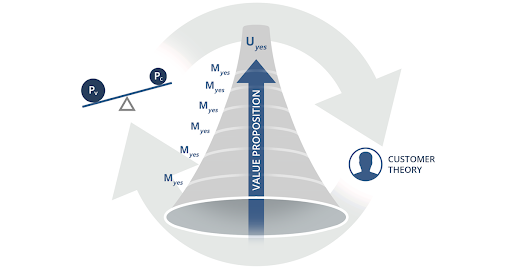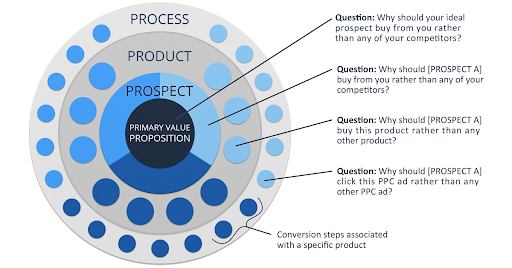eAccountable Framework Series
In the always changing landscape of digital marketing, maximizing your conversion rates is paramount to growing your business. To achieve this, it’s essential to employ a proven framework that can fine-tune your marketing collateral and optimize your customer’s journey. The MECLABS Conversion Sequence Heuristic gives you a structured approach to conversion optimization, helping you boost your sales and achieve sustainable success in your marketing efforts. So, without further ado, let’s dive into the Conversion Sequence Heuristic Framework, its significance, and how you can apply it in the real world.
What is the Conversion Sequence Heuristic Framework?
C = 4m + 3v + 2(i-f) – 2a
You might take a look at this and say: “Huh?”
Bear with us. First off, this isn’t an equation. It is a heuristic, which is a thought tool, framework, or very cool checklist that you can use to reference as you update your marketing content and collateral.
Here is the heuristic translated into layman’s terms:
The probability of Conversion (C) is dependent upon consumer Motivation (m), force of the Value Proposition (v), presence of Friction (f) and Anxiety (a) in the process, and Incentive (i) offsetting Friction that cannot be eliminated.
The Conversion Sequence Heuristic Framework was invented by the CEO and Managing Director of the MECLABs Institute, Flint McGlaughlin, based on years of testing and research of real product and service offers presented to real customers.”

The Inverted Funnel
Traditionally, the marketing funnel is depicted as a way to channel customers towards a single goal. Usually it is pointed down, and the potential customers are falling down the funnel toward an eventual conversion. The Conversions Heuristic framework flips this theory on its head with its inverted funnel of value propositions. At each stage in this framework, customers are not “falling” into your funnel; they are constantly evaluating and making decisions leading to a potential conversion at the top. The Conversion Sequence Heuristic takes this concept and encourages marketers to “invert” the funnel to understand that potential customers are climbing up through a series of micro-yes’s.
At each micro-yes juncture, prospects are weighing the perceived value of the action you’re asking them to take against the perceived cost. Your goal is to make these micro-yes decisions easy for them and keep them moving upwards in the funnel. If you don’t have a good enough answer, people will “fall out” of your funnel. Think of your marketing channels as a dynamic laboratory where you can experiment and iterate to get more people to say “yes” at each step.
The Levels of Value Proposition
Around each “micro-yes” juncture of the inverted funnel lies the most pivotal question from your customer’s perspective: “Why should I buy this product from you rather than any of your competitors?” To get your future customer up the entire funnel, you need a very good value proposition.
There are levels to a value proposition. You need to answer a series of questions for your customer:

- Primary Value Proposition: Why should I buy this product from you rather than any of your competitors?
- Prospect-level Value Proposition: Why should [PROSPECT A] buy from you rather than any of your competitors?
- Product-level Value Proposition: Why should [PROSPECT A] buy this product rather than any other product?
- Process-level Value Proposition: Why should [PROSPECT A] click this paid search ad rather than any other paid search ad?
When you have a strong answer for each of these questions, those micro yes junctions will get easier and easier.
The Five Factors for Conversion Rate Increases
Now that you understand the concept of the inverted funnel and the levels of a value proposition, let’s dive a little deeper into the Conversion Sequence Heuristic.
Remember, this is the “equation”:
C = 4m + 3v + 2(i-f) – 2a
Conversion (C) – The Foundation of Your Success
Optimization does not start with the Conversion Sequence Heuristic. It starts with determining the best endgoal—what is the right “macro-yes” to apply your resources to? Once you’ve answered this, the heuristic is a way to answer the next question: “What is the best way to achieve the objective?”
Many people immediately start with the heuristic elements on the right side of the equal sign and ignore the “C” – the probability of conversion. The truth is, you can’t proceed to optimization without having a deep understanding of:
- Who am I trying to convert? (Your target audience)
- What am I trying to convert them to? (Your product or service)
It can be dangerous to begin looking into motivation, value, incentive, friction, and anxiety before taking a step back and really thinking about what conversion looks like to you. That is the foundation on which you build your success.
Motivation (4m) – Who Are You Optimizing For?
The motivation of the prospect is the single most important factor affecting conversion. That’s why in the Conversion Heuristic it says 4m – the highest number before any element in the heuristic.
You can’t control a customer’s motivation, but you can learn to understand their motivation so you can better serve your customers while improving conversion.
Here are some questions you should ask yourself to understand your customer’s motivation:
- Where is your customer in the thought sequence?
- Where is the traffic coming from?
- What conclusions does your prospect need to make before buying?
- What are their pain points? What do they value?
Value Proposition (3v) – The “Only Factor”
Your value proposition is the second most important element, next to motivation. That’s why it says “3v” in the graphic. There are four elements that increase or decrease the force of your value proposition:
- Appeal – How much do I desire this offer?
- Exclusivity – Where else can I get this offer?
- Credibility – Can I trust your claims?
- Clarity – What are you actually offering?
Where “appeal” and “exclusivity” meet is your “only-factor”. When you clearly communicate your “only factor”, or the value your business provides that customer’s can’t get anywhere else, that’s when you convert.
Incentive and Friction (2(i-f)) – Working With Resistance
Incentive and Friction (2(i-f)) – Working With Resistance
Friction is the “aggravation factor”, or the hill the customer must climb over to complete the conversion goal. Friction can look like a long shopping cart process or a long form they must fill out before signing up for a subscription.
In the sales process, Friction consists of two components:
- Length-related friction – When a form or process asks for more time or information than feels reasonable to the prospect, it causes aggravation, irritation, and fatigue that could cause the customer to “fall off” the sales funnel.
- Difficulty-related friction – When a form or website has a bad user experience, it causes an undue amount of effort and confusion for the prospect.
You can’t avoid “friction” – it exists in every sales process. What you can do is offset it with the proper incentive. If the incentive for your product is high enough, your potential customer will jump through the necessary hoops to convert.
Anxiety (2a) – Working With Resistance
Anxiety is the intrusive thought at the end of the funnel that your product won’t deliver on its promises or that the checkout process isn’t secure. Anxiety can stop prospects in their tracks right as they are about to convert. At this stage, anxiety may not be rational so you need to tread lightly when addressing your customers concerns.
Here are three different ways you can seek to relieve or correct anxiety:
- Specificity – First, you need to identify what specifically is causing your prospect’s anxiety and address each concern effectively. Depending on the customer, it could be quality, reliability, price, security, privacy, and more.
- Proximity – After you’ve identified all the potential causes of anxiety, you should add “anxiety reducers” to your page. You can add small FAQs (frequently asked questions) to the checkout process that may alleviate any questions that come up.
- Intensity – Your anxiety reducer’s intensity level should address the rational foundation of the anxiety source while giving a realistic view of the risk. In other words, bring your customer back to earth with grounding facts that address their concerns and build back their trust.
What’s Next?
Want to figure out how to drive your customers up the inverted funnel? Our expert team of hands-on account managers at eAccountable can help you leverage the MECLABS Conversion Sequence Heuristic to boost your conversion rates. Drop us a line here for a free consultation, and let’s start optimizing your marketing efforts for greater success.
